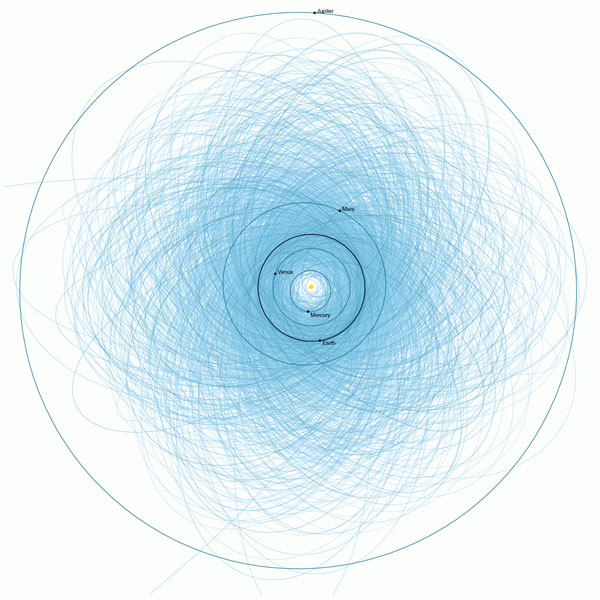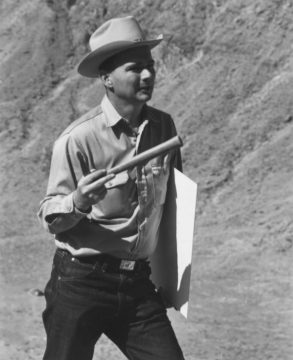There are some 25,000 near-Earth asteroids with diameters more than 140 meters. Amateur astronomers can find them — and the Planetary Society can help.
Update (December 20, 2019): The Planetary Society has awarded nearly $58,000 to amateur asteroid hunters. Read more about the winners here.
Last week, about 250 scientists, engineers, disaster experts, and officials from the world's space agencies met in Washington, D.C. for the biennial Planetary Defense Conference. There, NASA led attendees through a five-day disaster-response simulation centered on a killer asteroid heading toward Earth.
The scenario: a newly discovered city-block-size asteroid is on course to crash into us in 2027. How do we respond?

The Bruce Murray Space Image Library
Every day of the conference, participants decided on a course of action, as NASA advanced the fictional timeline by months or years. Ultimately, the group decided to launch a fictional fleet of international spacecraft to deflect the asteroid. But these were only partially successful — the simulation masters broke off a 60-meter-wide chunk of rock and aimed it straight for New York City, sending 10 million fictional people fleeing from the region.
Such a direct hit on one of the world's biggest cities is highly unlikely. Nevertheless, the threat from moderate-size asteroids is very real, according to a 2018 report by the White House's Office of Science and Technology. There are some 25,000 near-Earth asteroids with diameters more than 140 meters — and we don't know where most of them are.
"What we're looking for is to characterize 90% of asteroids that are 140 meters or bigger," said NASA Administrator Jim Bridenstine at the conference. "What does that mean, 140 meters? That means it's big enough to destroy a state in the United States of America. And we've only been able to detect, so far, one-third of those objects."

NASA / JPL-Caltech
The job of finding those asteroids mostly falls to the world's professional sky surveys. You may have heard of a few, such as Pan-STARRS at the University of Hawai‘i, LINEAR at MIT, and the Catalina Sky Survey at the University of Arizona. These surveys usually operate with a mix of government, institutional, and private funding, and are a crucial tool for planetary defense.
But what happens after sky surveys find something? Their observations represent single points in time as an object passes through a telescope's field of view. That's usually not enough to tell us how fast the object is rotating, whether it's actually a binary asteroid, or — most importantly — if it’s on course to hit Earth.
That's where amateur astronomers come in. These very capable skywatchers often own advanced backyard observatories or equipment located at dark sites that they can operate remotely. Observers may have day jobs quite outside of astronomy, but they have managed to turn a hobby into a bona fide scientific endeavor.
These astronomers aim their telescopes at single asteroids for hours, tracking the rise and fall of an object’s reflected sunlight as it tumbles across the sky. They send that data to the Smithsonian-operated Minor Planet Center (MPC), which acts as a clearinghouse for worldwide small-body observations. Groups like NASA's Center for Near Earth Object Studies then take multiple MPC observations and use them to compute orbits, which tell us whether an asteroid might be headed towards Earth.
Calling All Asteroid Hunters

USGS
In 1997, The Planetary Society launched the Shoemaker Near-Earth Object (NEO) grant program in honor of pioneering planetary scientist Gene Shoemaker, who advocated finding and studying the asteroids that might threaten our planet. Our grant winners are typically semi-professional astronomers who are already helping to find, track and characterize near-Earth asteroids but could use some extra funding to take their work to the next level. In the past 22 years, we've awarded $382,000 to 41 observers in 18 countries on 6 continents.
One of the grant's requirements is that awardees send us regular progress reports. Each year, we collect these reports and post the highlights at planetary.org. In recent years, our winners have helped discover binary asteroids, sometimes working with NASA in the process. They’ve tracked an asteroid that the Hubble Space Telescope showed was breaking apart like a comet. One observer has been the worldwide leader in observing very faint, 22nd-magnitude objects.
Their work also spreads beyond the realm of near-Earth asteroids. In 2018, we awarded a grant to a Moroccan observatory that is helping usher in an Arab astronomy renaissance. Some of our observers helped track ʻOumuamua, the mysterious interstellar space object that visited our solar system in 2017. A grant winner from Italy helped observe a Pluto stellar occultation in mid-2016.
Suffice it to say, planetary defense is a team sport, and we couldn't do it without the help of these semi-professional astronomers who labor in relative obscurity.
Are you one of them? If so, please check out our latest call for proposals for The Planetary Society Shoemaker NEO grant program, which we issued last week. We expect our grant sizes to range between $5,000 and $12,000 each, and proposals are due on July 30, 2019. If you’re a serious asteroid hunter who could use some financial help, we hope you’ll submit a proposal!
 1
1









Comments
Bob-Stetz
May 14, 2019 at 8:13 pm
How would one know if the object had been sighted before?
You must be logged in to post a comment.
You must be logged in to post a comment.